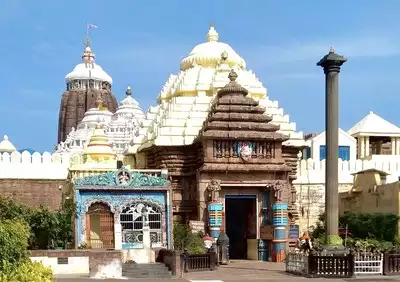Jagannath Temple in Puri, Odisha, India. Jagannath is a deity worshipped in Hinduism, and the Jagannath Temple is one of the most significant pilgrimage sites (Char Dham) for Hindus.

Table of Contents Show
Jagannath Temple, Puri
Jagannath Temple in Puri, dedicated to Lord Jagannath (a form of Lord Krishna), his sister Subhadra, and his elder brother Balabhadra. The temple is known for its unique rituals, architecture, and the annual Rath Yatra (chariot festival).
Rath Yatra
The annual Rath Yatra (chariot festival), is a grand event associated with Jagannath culture. During this festival, the deities are placed on large wooden chariots, and devotees pull these chariots through the streets of Puri.
Nabakalebara
Nabakalebara is a ritualistic tradition at the Jagannath Temple in Puri, involving the replacement of wooden idols of four Hindu deities with new ones. The term ‘Nabakalebara’ translates to ‘new embodiment.’
This ritual occurs every 8, 12, or 19 years, determined by astrological calculations.
The idols, crafted from neem trees, must meet specific criteria: light red bark, proximity to a snake, and featuring symbols of Shankha, Chakra, and Gada.
Rituals take place during the Adhikamasa (intercalary month) of Ashadha (June/July), coinciding with the occurrence of two lunar months of Ashadha in a single year.
This rare event typically transpires every 12 years, with the gap ranging from 8 to 19 years.
Chhapan Bhog
Chhapan Bhog is a special offering of 56 food items made to Lord Jagannath. Devotees believe that partaking in this prasad (blessed food) is highly auspicious.
General Knowledge on Jagannath Temple, Puri
| Location | Puri, Odisha, the eastern coast of India, on the Bay of Bengal |
| Alternative Names | Sri Kshetra Purushottam Kshetra Shankha Kshetra Sri Mandira Nilachala Khetra White Pagada |
| Deities | Jagannath Balabhadra Subhadra |
| Four Gates | Singhadwara (Lions Gate – Eastern) Hathi Dwara (Elephant Gate – Southern) Vyaghra Dwara (Tiger Gate – Western) Ashwa Dwara (Horse Gate – Northern) |
| Temple Built By | Anantavarman Chodaganga Deva (Prominent King of the Eastern Ganga dynasty) |
| Architectural Style | Kalinga architecture |
| Significance | One of the Char Dham pilgrimage sites for Hindus |
| Four Temples | Biman, Mukhasala, Nata Mandap, Bhoga Mandap |
| Festivals | Ratha Yatra Chandan Yatra Snana Yatra Nabakalebara |
| Main Festival | Rath Yatra (Chariot Festival) |
| Chariot Names (Raths) | Nandighosa (Jagannath) Taladhwaja (Balabhadra) Darpadalana (Subhadra) |
| Chariot Colors | Red and Yellow (Jagannath) Green and White (Balabhadra) Red and Black (Subhadra) |
According to legend, the construction of the first Jagannath temple was built by King Indradyumna, son of Bharata and Sunanda, and a Malava king, mentioned in the Mahabharata and the Puranas.
